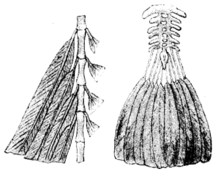Archaeopteryx
![]()
The title of this article is ambiguous. For other meanings, see Archaeopteryx (disambiguation).
Archaeopteryx (from Ancient Greek ἀρχαῖος archaîos "ancient" and πτέρυξ ptéryx "wings, wings, feather", pronunciation: Archeo-ptéryx; mutatis mutandis "ancient wing" or "primordial wing") is a genus of archosaur whose fossils were discovered in the Franconian Alb in the Upper Jurassic Solnhofen plate limestones. Archaeopteryx is considered a transitional form that mediates between theropod dinosaurs and the birds. Since Archaeopteryx, which is about the size of a raven, is generally considered to be close to the origin of birds, the members of the genus are also referred to as primitive birds.
Archaeopteryx was first described in 1861 by Hermann von Meyer on the basis of an isolated feather print. The first skeleton specimen (the so-called London specimen) was already discovered in the same year and is mentioned in the first publication. To date, at least 11 other skeletal specimens of varying degrees of completeness have followed.
Features
The genus Archaeopteryx shows a mosaic of (for birds) primitive, i.e. reptilian characteristics, which were later discarded by modern birds (Neornithes), and derived, i.e. bird-typical characteristics (which, however, according to the present state of knowledge are only partly considered to be solely characteristic of birds).
Primitive features include the presence of teeth and abdominal ribs (gastralia), a long caudal spine, a relatively small number of unfused pelvic vertebrae (sacralia), unfused metacarpal, metatarsal, tarsal, and pelvic bones, the three finger claws, and the absence of a bony sternum.
To the bird-typical characteristics, one can count the modern seeming asymmetrical swing-feathers, furthermore the clavicles merged to a fork-leg and the backward or laterally-backward oriented first toe (Hallux) of the foot (anisodactyler bird-foot).
Archaeopteryx reached about the size of ravens (about 50 cm body length) and a weight of 0.8 to 1 kg.

Anatomical representation with comparison of the "frond tail" of Archaeopteryx with the "fan tail" of a modern bird
Meaning
The avian characteristics of the proto-bird are also attested for some feathered dinosaurs or, as in the case of the reverted first toe of Archaeopteryx, are not unchallenged. Therefore, some paleontologists do not consider the proto-bird to be significantly more bird-like than some theropod dinosaurs that are not classified as birds (e.g. Microraptor).
Within the last 20 years, a large number of fossils of primitive birds and bird-like dinosaurs have been discovered, especially in sedimentary rocks of the Lower Cretaceous of Northeast China (the Jehol Group). Thus, Archaeopteryx does not stand alone as a mosaic form, but can be placed in a (morphological, not temporal) sequence of dinosaurs that successively became more similar to birds.
Proponents of the hypothesis that the flapping flight of birds evolved from gliding down from an elevated point interpret the claws of Archaeopteryx as those of a tree climber gliding down from the branches. During palecological investigations of the find horizons, however, some researchers came to the conclusion that a hot and dry climate must have prevailed at the place of formation of the Solnhofen plate limestones and that trees probably did not occur. In turn, however, they pointed to high cliffs on the coast of the Jurassic Sea as a possible starting point for the first attempts at flight. Burgers and Chiappe showed that Archaeopteryx may also have been able to take off from the ground.
Research examining the eleventh fossil known to date with the best-preserved feathers to date shows that Archaeopteryx was probably feathered over its entire body. Long feathers on the legs were arranged in rows, and by their shape they probably had no function in flying (as is thought in the distantly related Microraptor), but they may have been useful in landing, similar to the feathered trousers of recent birds of prey. The plumage probably served, similar to the related groups, not only for flying but also for thermal insulation, probably it also had functions as a signaling device to conspecifics or for camouflage. A special feature of the flight feathers used for flying is their asymmetrical plume.
Questions and Answers
Q: What is Archaeopteryx?
A: Archaeopteryx is a flying dinosaur from the Upper Jurassic, about 150 million years old.
Q: What is the significance of Archaeopteryx?
A: Archaeopteryx is important because it shows the evolutionary link between non-avian theropod dinosaurs and birds.
Q: Is Archaeopteryx the ancestor of modern birds?
A: No, archaeopteryx is not the ancestor of modern birds.
Q: Where was the first Archaeopteryx found?
A: The first Archaeopteryx was found in 1860 near Solnhofen in Bavaria, Germany.
Q: How many Archaeopteryx skeletons have been found to date?
A: Today, ten skeletons and one feather of Archaeopteryx have been found.
Q: What are some of the physical characteristics of Archaeopteryx?
A: Archaeopteryx was a small carnivorous dinosaur with feathers and wings. It had a mouth with teeth, claws on the hands and a long tail.
Q: What other extinct theropods looked like birds and had feathers?
A: It is known that dromaeosaurs, and possibly most other extinct theropods looked like birds and had feathers.
Search within the encyclopedia